| . J.L. Simonton, W.D. Cole and P. Williams International Textile Center Texas Tech University Lubbock, TXv INTORDUCTION: The basic purpose of this study is to examine the use of the AFIS and the HVI to improve performance of the spinning process. Since the various mechanical processes modify the state of the fibers, we must first determine the effects of fiber preparation on instrument readings. Cotton processing machines that mechanically work the cotton fiber from bale to yarn are designed with the intent of minimizing fiber damage. Nevertheless, opening, cleaning and blending equipment shorten the staple length while increasing short fiber content and neps. Carding and combing reverse this by removing a percentage of the short fibers and neps. Drawing is thought to have a minimal effect on fiber physicals, its purpose being to improve sliver evenness and fiber orientation. With machine settings and speeds optimized, a comparison of the fiber properties of stock-in compared with stock-out provides valuable information for achieving further optimization. . PROCEDURE: -
Instrument used: Uster AFIS and HVI Spinlab 900B -
No. of bale samples: 10 bales with different mic and length were used -
No. of processing method : 12 different processing combinations -
Machineries used:
Blow room: hunter hopper feeder Rieter Mono cylinder (750 rpm) Rieter ERM B5/5(850 rpm) Rieter ERM B5/5(950 rpm) Carding : Rieter C4 card with Hollingsworth Trashmaster TM2000 (100 pounds per hour, with 60 grains per yard sliver) Drawframe: Rieter RSB-851 Speed frame:Saco Lowell Rovematic FC-1B Ring spinning: Saco Lowell SF-3H Open end machine: Schlafhorst Autocoro Predrawframe for comber: Saco-Lowell DE-7C Lap former : Rieter Unilap E5/3 Comber : Rieter E7/6
DETAILS OF THE FINDINGS: -
There are slight AFIS variations in the apparent fiber diameter when going from a processing stage to another. It seems that the ERMII results in a slight increase, which could be due to the removal of dead fibers in the opening line. Certainly the card also removes neps and dead fibers; however, the diameter appears to decrease slightly (Figure ) There is also a significant decrease due to the drawing. These mechanical processes cannot modify the diameter. The only logical explanation is an artifact effect. In the card sliver and the drawing slivers the fibers are oriented and paralleled, this removes the crimp. The length of the electronic signal and its height are then modified giving higher length readings and lower diameter readings.
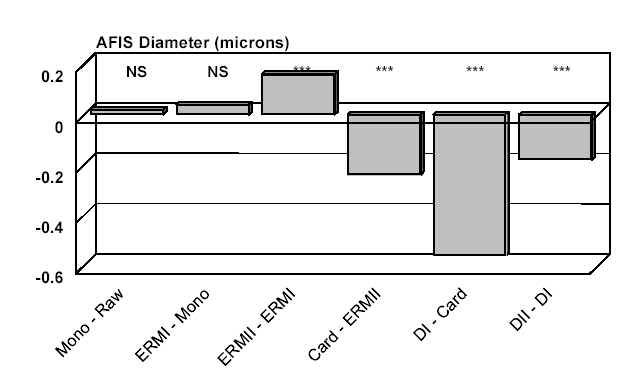
-
The HVI micronaire values (Figure 1) vary slightly in the opening line, perhaps due to the removal of some dead fibers. The carding seems to reduce the micronaire, which is not explainable. Then the drawing leads to an increase in micronaire. The theory of the micronaire instruments is based on airflow passing through a sample constituted of randomly oriented fibers. In the drawing process the fibers are made parallel, which probably leads to an easier flow of air through the cotton sample and results in an apparent higher micronaire.
FIG:1 
-
As the micronaire is used to calculate the beard mass (function of optical density and micronaire) for the strength test, any positive micronaire bias will lead to a negative HVI strength bias (Figure 2). In addition, the drawing process is similar in effect to an increase in the brushing time (or force) on the HVI combs. Taylor (TRJ, 1986, 93-102) has shown the effect of increasing brushing force on HVI strength readings. In his experiment two sample preparations were tested, hand brushing and HVI brushing (harder brushing than by hand). The results show an increase by 1.9 g/tex when using the HVI brushing device. In our case, we think that the drawing sliver samples have a lower optic density (for a given number of fibers in the comb) than the raw cotton. This results in a lower calculated mass of the sample to be broken. As the HVI strength is calculated by dividing the force applied to break the sample by the
FIG:2 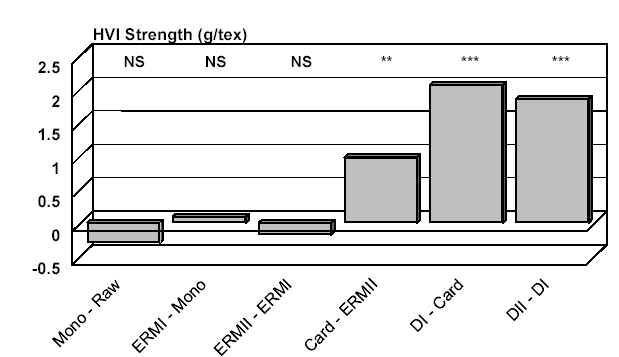
-
As expected, the AFIS nep counts (Figure 3) increase with passage of the fibers through the opening line. The Mono- cylinder increases the average nep count by 75, then the first ERM (operating at 850 rpm) by 136 and the second ERM (operating at 950 rpm) by 240; that is 451 neps in total. The card removes 540 neps and the drawing frames have no effect.
FIG:3 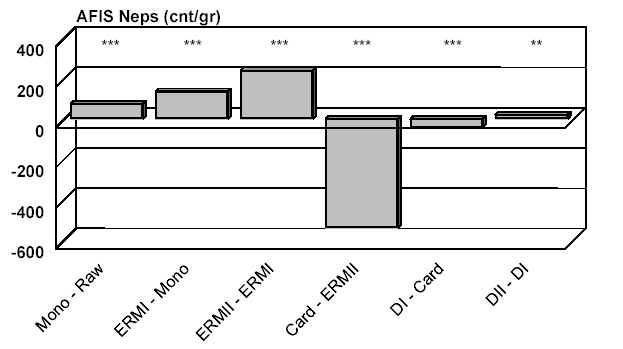
FIG:4 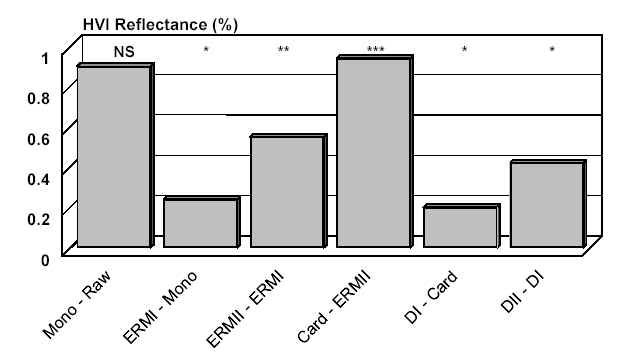
FIG:5 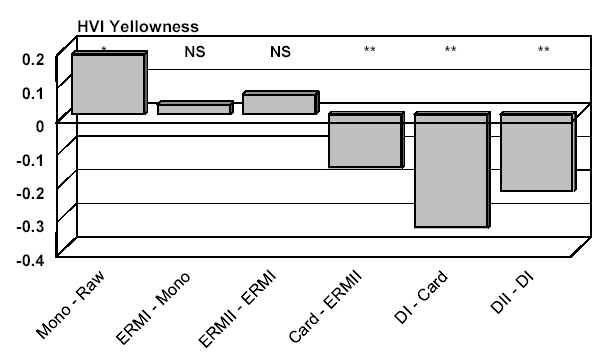
Combed Process: -
Combing affects AFIS Upper Quartile Length, Mean Length, Short Fiber Content and HVI Upper Half Mean Length and Uniformity Ratio. As expected the fiber length parameters all increase when the cotton is combed, with the exception of the Short Fiber Content.
The drawing also affects the length parameters; as discussed before, it is probably an artifact. It is interesting to note that combing increases the length by 0.006 inch (minimum noil settings) and that the first drawing increases it by 0.027, i.e. nearly five times more. The artifact effect seems to be much more important than the real mechanical effect. The combing process seems to have no effect on the fiber diameter (Figure 6). The drawing, as discussed before, decreases the diameter (artifact). The HVI micronaire (Figure 7) increases when combing is applied, mainly because the removal of short, weak and immature fibers during the combing process increases the average maturity level. As discussed before the drawing has a positive effect on micronaire (artifact effect).
FIG:6 AFIS-DIAMETER 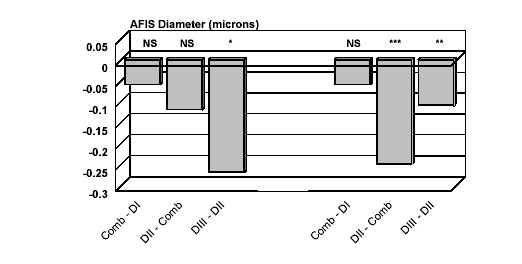
FIG:7 HVI STRENGTH: 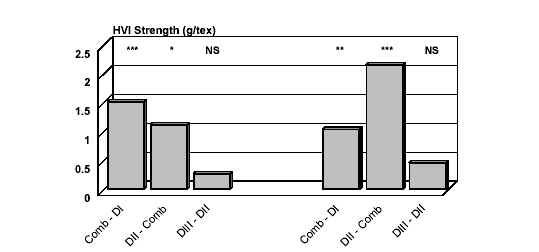
-
The HVI strength (Figure 8) also increases with combing, because of the removal of short fibers. The drawing, as discussed before, increases the apparent HVI strength (artifact effect).
FIG:8 HVI STRENGTH 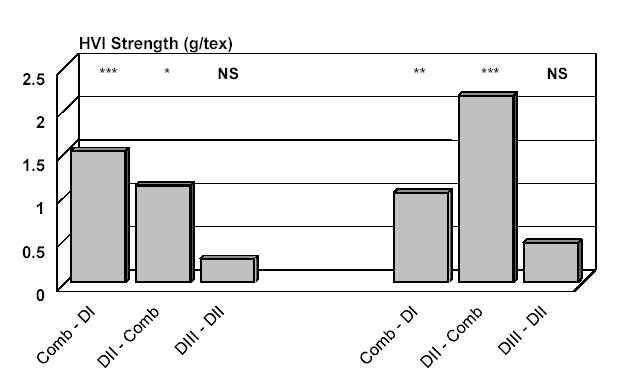
FIG:9 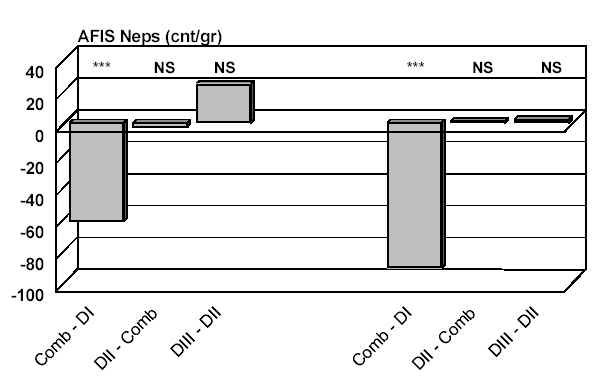
-
The combing also removes trash and dust. The decrease in trash is (Figure 10) nearly 60% for both types of settings. The decrease in dust (Figure 11) is about 40% for the minimum noil setting and 60% for the normal noil setting. As these are removed the HVI reflectance increases as expected and the yellowness decreases. The drawing effect on both parameters is an artifact, as discussed before.
FIG:10 AFIS-TRASH: 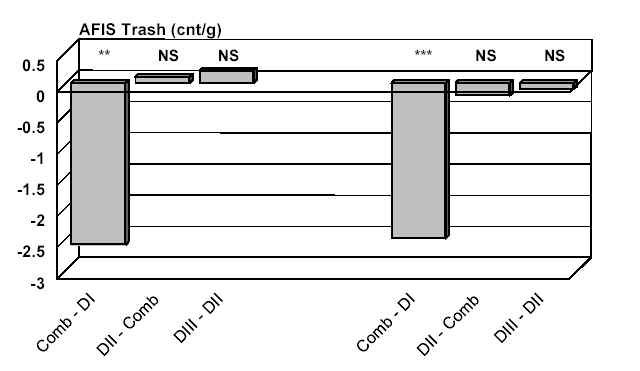
FIG:11 AFIS DUST 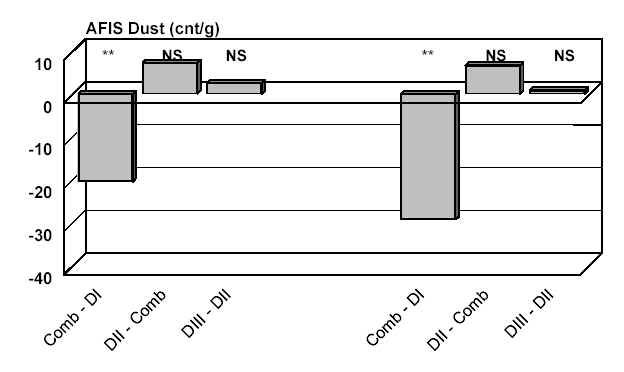
. | 










